

The Beauty Of Typography: Writing Systems And Calligraphy Of The World - Smashing Magazine. Gairaigo. Ateji. Ateji (jap.
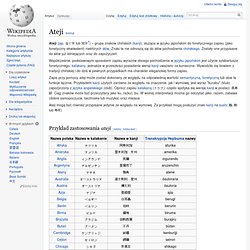
当て字 lub 宛字?) – grupa znaków chińskich (kanji), służąca w języku japońskim do fonetycznego zapisu (jako fonetyczny ekwiwalent) niektórych słów. Znaki te nie odnoszą się do słów pochodzenia chińskiego. Zostały one przypisane do słów już istniejących oraz do zapożyczeń. Współcześnie, podstawowym sposobem zapisu wyrazów obcego pochodzenia w języku japońskim jest użycie sylabariusza fonetycznego, katakany, jednakże w przeszłości posiadanie wersji kanji uważano za konieczne.
Zapis przy pomocy ateji może zostać dokonany ze względu na odpowiednią wartość semantyczną, fonetyczną lub obie te funkcje łącznie. Ateji mogą być również przypisane jedynie ze względu na wymowę. Man'yōgana. Man’yōgana (jap.
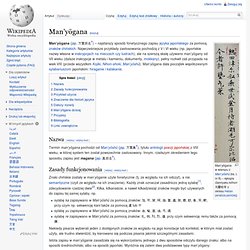
万葉仮名?) – najstarszy sposób fonetycznego zapisu języka japońskiego za pomocą znaków chińskich. The kanji history. Iroha. The Iroha (いろは?)
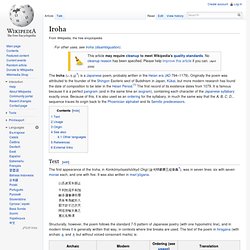
Is a Japanese poem, probably written in the Heian era (AD 794–1179). Originally the poem was attributed to the founder of the Shingon Esoteric sect of Buddhism in Japan, Kūkai, but more modern research has found the date of composition to be later in the Heian Period.[1] The first record of its existence dates from 1079. It is famous because it is a perfect pangram (and in the same time an isogram), containing each character of the Japanese syllabary exactly once. Because of this, it is also used as an ordering for the syllabary, in much the same way that the A, B, C, D... sequence traces its origin back to the Phoenician alphabet and its Semitic predecessors. Wāpuro rōmaji. Wāpuro rōmaji (ワープロローマ字?)
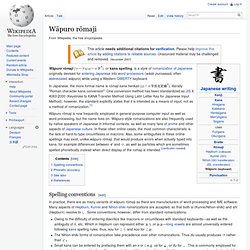
, or kana spelling, is a style of romanization of Japanese originally devised for entering Japanese into word processors (wādo purosessā, often abbreviated wāpuro) while using a Western QWERTY keyboard. Baka (fool) Okurigana. Okurigana (送り仮名, accompanying letters?)
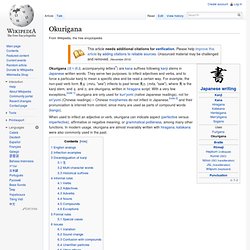
Are kana suffixes following kanji stems in Japanese written words. They serve two purposes: to inflect adjectives and verbs, and to force a particular kanji to mean a specific idea and be read a certain way. For example, the non-past verb form 見る (miru, "see") inflects to past tense 見た (mita, "saw"), where 見 is the kanji stem, and る and た are okurigana, written in hiragana script. With a very few exceptions,[note 1] okurigana are only used for kun'yomi (native Japanese readings), not for on'yomi (Chinese readings) – Chinese morphemes do not inflect in Japanese,[note 2] and their pronunciation is inferred from context, since many are used as parts of compound words (kango). When used to inflect an adjective or verb, okurigana can indicate aspect (perfective versus imperfective), affirmative or negative meaning, or grammatical politeness, among many other functions.
English analogs[edit] Inflection examples[edit] Yojijukugo. Yojijukugo (四字熟語?)
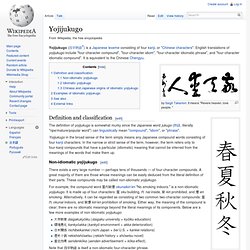
Is a Japanese lexeme consisting of four kanji, or "Chinese characters". English translations of yojijukugo include "four-character compound", "four-character idiom", "four-character idiomatic phrase", and "four-character idiomatic compound". It is equivalent to the Chinese Chengyu. Definition and classification[edit] Yojijukugo in the broad sense of the term simply means any Japanese compound words consisting of four kanji characters. Hentaigana. Hiragana (and katakana) originate in man'yōgana, a system where kanji were used to write sounds without regard to their meaning.
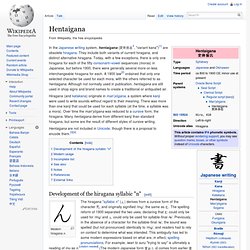
There was more than one kanji that could be used for each syllable (at the time, a syllable was a mora). Over time the man'yōgana was reduced to a cursive form, the hiragana. Many hentaigana derive from different kanji than standard hiragana, but some are the result of different styles of cursive writing. Hentaigana are not included in Unicode, though there is a proposal to encode them.[3][4] Development of the hiragana syllabic "n"[edit] Modern hiragana n.
Modern usage[edit] A soba restaurant with a sign using hentaigana. Katakana. Katakana are characterized by short, straight strokes and angular corners, and are the simplest of the Japanese scripts.[3] There are two main systems of ordering katakana: the old-fashioned iroha ordering, and the more prevalent gojūon ordering.
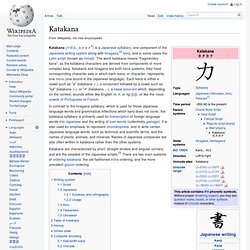
Writing system[edit] Script[edit] The complete katakana script consists of 48 characters, not counting functional and diacritic marks: Historical kana orthography. The historical kana orthography (歴史的仮名遣, rekishiteki kanazukai?)
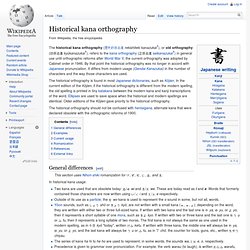
, or old orthography (旧仮名遣, kyūkanazukai?) , refers to the kana orthography (正仮名遣, seikanazukai?) In general use until orthographic reforms after World War II; the current orthography was adopted by Cabinet order in 1946. By that point the historical orthography was no longer in accord with Japanese pronunciation. It differs from modern usage (Gendai Kanazukai) in the number of characters and the way those characters are used. We (kana) ゑ, in hiragana, or ヱ in katakana, is a nearly obsolete Japanese kana.
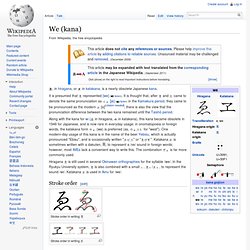
It is presumed that ゑ represented [we] ( ). It is thought that, after ゑ and え came to denote the same pronunciation as イェ [je] ( ) in the Kamakura period, they came to be pronounced as the modern エ [e][citation needed]; there is also the view that the pronunciation difference between the two kana remained until the Taishō period. Hiragana ゑ is still used in several Okinawan orthographies for the syllable /we/.